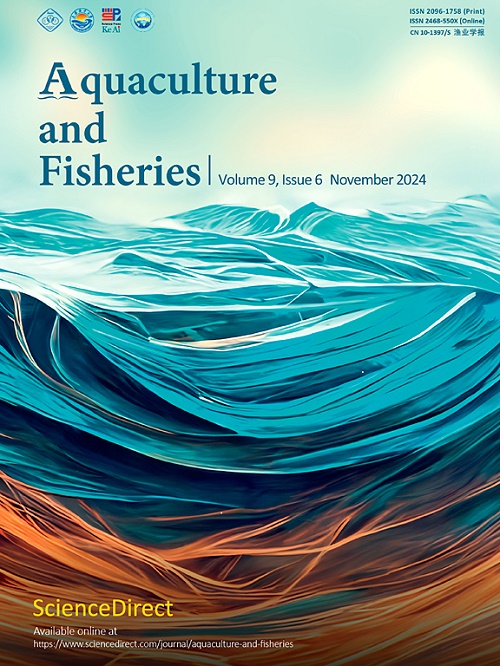从枯草芽孢杆菌中提取的硒纳米颗粒的表征及其对大长爪甲的抗菌作用:对铁下垂的研究
Q1 Agricultural and Biological Sciences
引用次数: 0
摘要
硒纳米颗粒(SeNPs)常被用作生长和抗氧化能力的促进剂。在本研究中,我们发现硒纳米颗粒(SeNPs)作为饲料添加剂,在嗜水气单胞菌(a . hydroomonas phila)攻毒后,可以提高大lepis Onychostoma fry (O. macrolepis)的存活率。为了进一步探讨SeNPs抗细菌感染的机制,我们检测了细菌感染前后SeNPs的变化,结果表明,在嗜水芽胞杆菌感染下,大虾苗体内会产生大量过氧化物,过氧化物的过度积累导致肝脏内大量铁下垂。有趣的是,我们发现在受嗜水气单胞菌攻击后,添加0.9 mg/kg生物源性SeNPs可降低大鳞虾肝脏中丙二醛(MDA)、铁含量,并提高T-AOC水平(P小于0.01)。特别是,饲粮中添加0.9 mg/kg生物源性SeNPs可显著提高嗜水单胞杆菌感染后大鼠肝脏中谷胱甘肽过氧化物酶-4 (GPX4)、核因子红细胞2相关因子2 (Nrf2)和铁转运蛋白1 (FPN1)的表达水平。综上所述,本研究结果提示,饲料中添加0.9 mg/kg生物源性SeNPs是通过提高大鲤鱼苗抗氧化能力和抑制铁下垂来提高鱼苗存活率的最佳添加剂量,这从铁下垂的角度为鱼类抗菌感染的机制提供了新的思路。本文章由计算机程序翻译,如有差异,请以英文原文为准。
Characterization of selenium nanoparticles extracted from Bacillus subtilis and its antibacterial effects in Onychostoma macrolepis: Insight into ferroptosis
Selenium nanoparticles (SeNPs) were often used as growth and antioxidant capacity promoter. In this study, we found selenium nanoparticles (SeNPs) could improve the survival rate of Onychostoma macrolepis (O. macrolepis) fry as a feed additive after a challenged by Aeromonas hydrophila (A. hydrophila). To further explore the mechanism of SeNPs against bacterial infection, we examined the changes before and after bacterial infection, and the results showed that large amounts of peroxide were produced under A. hydrophila infection in O. macrolepis fry, and then the excessive accumulation of peroxides led to a large amount of ferroptosis in the liver. Interestingly, we found supplementing 0.9 mg/kg biogenic SeNPs decreased MDA, iron content, and enhanced T-AOC levels in the liver of O. macrolepis fry after a challenged by Aeromonas hydrophila (P˂0.01). Especially, the diet with 0.9 mg/kg biogenic SeNPs could significantly increase the expression level of Glutathione peroxidase-4 (GPX4), nuclear factor erythroid2-related factor 2 (Nrf2), and Ferroportin 1 (FPN1) in the liver of O. macrolepis after infection with A. hydrophila. In summary, the results of this research suggested that the diet with 0.9 mg/kg biogenic SeNPs was an optimal additive dose to improve the survival rate of O. macrolepis fry by increasing antioxidant capacity and inhibiting ferroptosis, which sheds a new light on the mechanism of antibacterial infection in fish from the perspective of ferroptosis.
求助全文
通过发布文献求助,成功后即可免费获取论文全文。
去求助
来源期刊

Aquaculture and Fisheries
Agricultural and Biological Sciences-Aquatic Science
CiteScore
7.50
自引率
0.00%
发文量
54
审稿时长
48 days
期刊介绍:
 求助内容:
求助内容: 应助结果提醒方式:
应助结果提醒方式:


